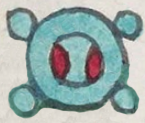xihuitl (Mdz7v)
This element for turquoise (xihuitl), the gem and the color, has been carved from the compound sign for the place name, Xiuhtepec. It has four small circles around the perimeter of a large circle. Another concentric circle appears inside the larger circle. Thus, it has a quincunx shape. Everything is colored turquoise with the exception of two small, vertical, red almond-like shapes inside the innermost circle.
Stephanie Wood
The iconography of this turquoise gem may suggest a shimmer or shine in the small circles around the perimeter, as they are reminiscent of the small circles on the outside of the chalchihuitl (jade), the tezcatl (mirror), and the tonatiuh (sun, day). Water droplets that splash off of the atl glyph (along with shells) also catch the light and may suggest shine. Xihuitl also refers to a year in the calendar. Its quincunx shape (quadripartite) of the turquoise stone recalls the four cardinal directions and conceptualizations of the cosmos (astronomical and calendrical). The Florentine Codex (Book XI) includes various gradations of xihuitl, from mundane to especially precious: xihuitl (ordinary), teoxihuitl (god-like), and tlapalteoxihuitl (an exceptionally colored turquoise). These terms raise the supernatural significance of some turquoise in Indigenous religious belief and practice. [See Molly Bassett's presentation on the Florentine Codex at the Getty Research Institute in 2015.]
Other known representations of the stone xihuitl sign can have a mosaic-like representation of the turquoise (see the Matrícula de Tributos, f. 3 verso). Turquoise-covered objects are often found to have clusters of small stones (tesserae) put together in mosaics. The two flint-shaped inner pieces of this xihuitl sign have been known to have a mosaic-like character, too (see Taube 2012, fig. 12d–f). The appendices of the book, Conceptualization of 'Xihuitl,' by Mutsumi Izeki includes a great many objects covered with turquoise tesserae.
The red color has yet to be analyzed fully, but the "pairing of red and [turquoise] blue" may have had references to the atl tlachinolli (sacred warfare) and imperial expansion according to Andrea Feeser. Feeser also cites Eleanor Wake for noting that turquoise and red combined "as the chromatic metaphor for the source of life." [See: The Materiality of Color, 2017, p. 57.] Mutsumi Izeki identifies fire and the color red as an "extended sense" of xihuitl as exemplified in Xiuhtecuhtli, a divine force often called the "god of fire," the "god of year," and the "god of turquoise." Izeki links the color red with the color of fire and of the sun. [See: Conceptualization of 'Xihuitl,' 2008, 34–35.] Janice Robertson (2017, 193) sees the red around the chalchihuitl as having the purpose of pulsating; one could see these colors in a similar way.
Stephanie Wood
c. 1541, but by 1553 at the latest
turquesas, joyas, guerra sagrada, xiuhpohualli, año, xihuitl

xihui(tl), turquoise, https://nahuatl.wired-humanities.org/content/xihuitl-0
xihui(tl), year, https://nahuatl.wired-humanities.org/content/xihuitl
a(tl) tlachinol(li), water and scorched earth, sacred warfare, https://nahuatl.wired-humanities.org/content/atl-tlachinolli
la turquesa y/o el año
Stephanie Wood
Codex Mendoza, folio 07 verso, https://digital.bodleian.ox.ac.uk/objects/2fea788e-2aa2-4f08-b6d9-648c00..., image 25, of 188.
The Bodleian Libraries, University of Oxford, hold the original manuscript, the MS. Arch. Selden. A. 1. This image is published here under the UK Creative Commons, “Attribution-NonCommercial-ShareAlike 3.0 License” (CC-BY-NC-SA 3.0).





